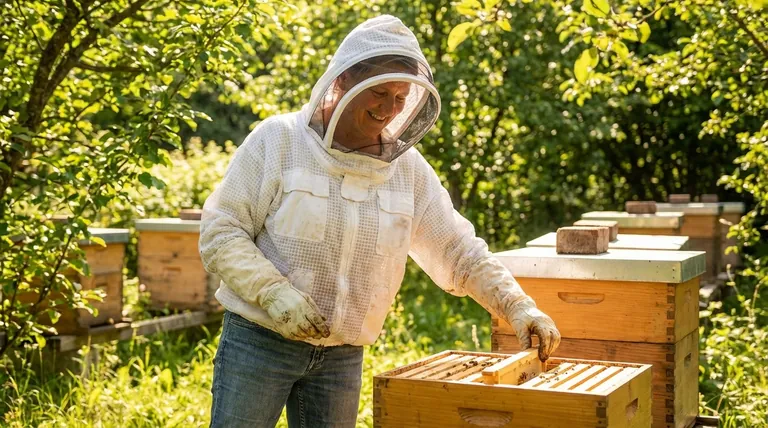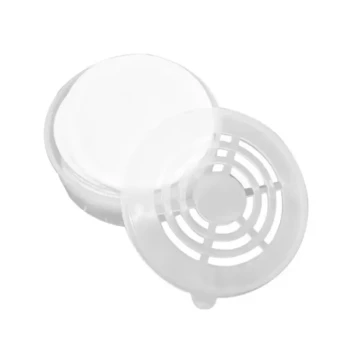For beekeepers prioritizing speed and comfort, a bee jacket offers significant advantages over a full suit. Its primary benefits are that it is much faster to put on and take off, less cumbersome during inspections, cooler in hot weather, and generally more affordable. This makes it an excellent choice for quick, routine hive checks where full-body protection is not the top priority.
A beekeeping jacket is not a lesser version of a full suit, but a specialized tool. It trades the absolute, head-to-toe security of a suit for superior speed, mobility, and comfort during less intensive apiary tasks.

The Core Advantages: Speed and Mobility
The most immediate benefits of a bee jacket relate to its ease of use and the freedom of movement it provides. These factors directly impact the efficiency and enjoyment of your beekeeping tasks.
Rapid Gearing Up and Down
A jacket can be put on or taken off in seconds, often just by zipping it up over your regular clothes. This is a stark contrast to the more involved process of stepping into and securing a full bee suit.
This speed is invaluable for short, targeted tasks like refilling a feeder, checking mite boards, or performing a quick population check.
Enhanced Comfort and Dexterity
Without the bulk of full-leg coverings, a jacket is significantly less cumbersome. This allows for more natural bending, squatting, and movement around the apiary.
This increased comfort and dexterity can make delicate tasks inside the hive, such as handling frames or marking a queen, feel less restrictive.
Superior Temperature Regulation
By leaving your lower body exposed to the air, jackets are inherently cooler than full suits. This is a major advantage for beekeepers working in warm climates or during the peak heat of summer.
Many modern jackets also come in ventilated or partially ventilated designs, which use layered mesh to promote airflow while still preventing stings, further enhancing their cooling properties.
Practical and Economic Benefits
Beyond the in-apiary experience, bee jackets offer practical advantages in terms of cost and storage that are especially appealing to new or hobbyist beekeepers.
A More Accessible Entry Point
Bee jackets are consistently less expensive than their full-suit counterparts. This lower price point makes them a highly accessible piece of protective equipment for individuals just starting their beekeeping journey.
Simplified Storage and Transport
A jacket is less bulky and takes up significantly less space than a full suit. This makes it easier to store in a garage, shed, or vehicle, simplifying the logistics of managing your beekeeping gear.
Understanding the Trade-offs
The convenience of a bee jacket comes with a clear and important compromise: reduced protection. Being an effective beekeeper means understanding and accepting these trade-offs.
Compromised Lower Body Protection
The most obvious drawback is the lack of protection for your legs. While wearing thick jeans offers some defense, they are not sting-proof, especially against a determined bee.
You will also inevitably get propolis and wax on your pants, which can be difficult to remove.
The Risk of an Exposed Waistline
The critical point of failure for a jacket is the gap that can open at your waist when you bend over—a very common posture in beekeeping.
Bees that feel threatened can crawl up under the jacket's elastic hem, leading to stings in a vulnerable area. While a tight belt or tucked-in shirt can mitigate this, it remains a potential risk not present with a one-piece suit.
Making the Right Choice for Your Goal
Your decision to use a jacket or a suit should be based on the task at hand and your personal comfort level with the bees.
- If your primary focus is quick, routine inspections: The jacket is an ideal tool for its speed and convenience.
- If you are working with a defensive hive or performing invasive work: The comprehensive security of a full bee suit is the wiser choice.
- If you are a new beekeeper or have a known bee sting allergy: Prioritize maximum protection with a full suit until you gain experience and confidence.
Ultimately, choosing the right protective gear is about matching the tool to the specific demands of your work in the apiary.
Summary Table:
| Advantage | Description |
|---|---|
| Speed & Convenience | Faster to put on/take off for quick hive checks. |
| Enhanced Mobility | Less cumbersome, allowing for better bending and movement. |
| Cooler Comfort | Better airflow keeps you cooler in warm weather. |
| Cost-Effective | More affordable than a full bee suit, ideal for beginners. |
Ready to experience the speed and comfort of a professional bee jacket? HONESTBEE supplies commercial apiaries and beekeeping equipment distributors with high-quality, durable protective gear designed for efficiency. Let us help you equip your operation with the right tools for the job. Contact our wholesale team today to discuss your needs!
Visual Guide

Related Products
- Inner Beehive Cover for Beekeeping Bee Hive Inner Cover
- Wholesales Dadant Size Wooden Bee Hives for Beekeeping
- Long Langstroth Style Horizontal Top Bar Hive for Wholesale
- Heavy-Duty Stainless Steel Clip-On Frame Perch
- JZBZ Langstroth Queen Rearing Frame for Beekeeping
People Also Ask
- What is the role of the inner cover in a beehive? Essential Climate Control for Hive Health
- What is the purpose of the inner cover in a beehive? A Key to Hive Health & Easy Management
- What is the role of inner covers in insulated beehives? Master Moisture Control for a Healthy Colony
- What are the advantages of using an inner cover in a beehive? Key Benefits for Hive Health & Beekeeper Efficiency
- Why might beekeepers use an inner cover under the telescoping outer cover? Simplify Hive Management & Protect Your Colony



















